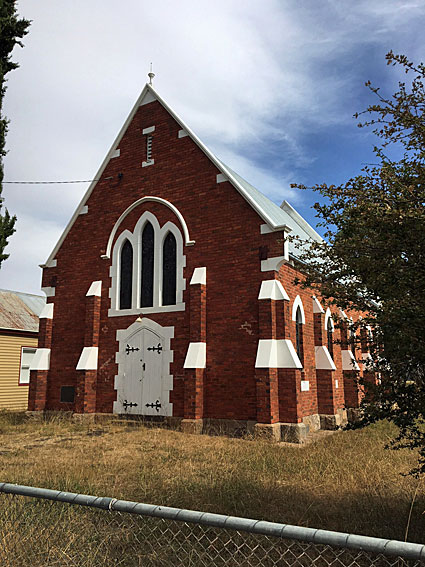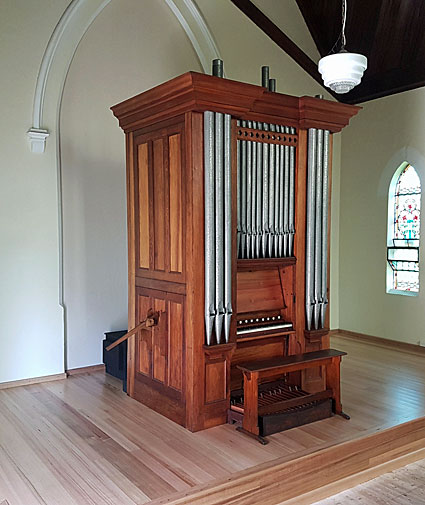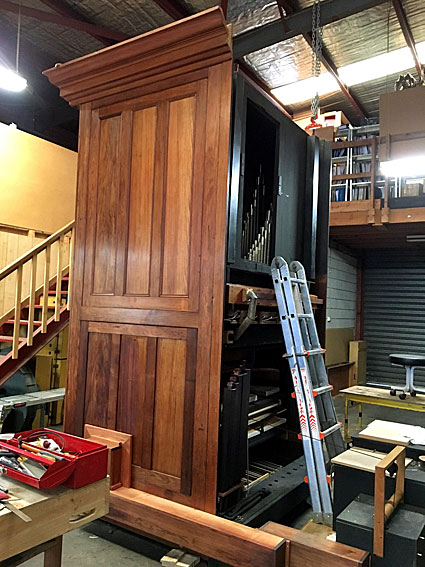
Fincham Hall, Dunkeld - exterior
(photograph by John Maidment [26 January 2018])

Fincham Hall, Dunkeld - exterior
(photograph by John Maidment [26 January 2018])
Historical and Technical Documentation by John Maidment
© OHTA, 2018 (last updated January 2018)
The foundation stone of the Methodist Church, Dunkeld was laid on 16 August 1913 by Mrs G. Taylor. The architects were Clegg, Miller & Cain, of Hamilton, and the builder E.B. Patterson.1 The building was opened on 17 January 1914.2 The church has now closed for worship and it has been acquired by Allan and Maria Myers who have carried out essential maintenance work and erected a new wooden platform for the organ. It is proposed that the building and organ be used for concerts and community events. It has been named to honour Australia's pre-eminent organbuilder from the 19th century.
The organ was built by George Fincham. It was opened in May 1875 at the Wesleyan (Methodist) Church, Coburg.3 It appears to have been built as a residence organ, possibly around 1870-73, with the name of Henry Kemmis inscribed in pencil inside the swell box.4 An Open Diapason of remnant pipes was later installed, together with a Principal (Dulcet), which Fincham described in 1897 as being of "wretched condition".5 The use of mahogany for the casework is an unusual choice, maybe chosen to match adjacent furniture in a private residence.

Wesleyan Church, Coburg showing the Fincham organ
(courtesy of the Coburg Historical Society [c.2004])
An illustration of the organ at the Coburg church, during a Harvest Sunday celebration, was found in the archives of the Coburg Historical Society.6 In 1924, the Coburg church acquired a two-manual organ from J.E. Dodd, of Adelaide, displacing the Fincham organ. A letter survives in the Dodd letter books to Messrs Findlay and Co, Launceston, offering this organ for sale at a cost of £350:
"But if you can see your way of placing a second hand one manual organ in Tasmania I have one in Melbourne which I can guarantee has been thoroughly renovated and is now as good as new... Design is good and solid looking..."7
The instrument went to St Joseph's Catholic Church, Port Melbourne probably later in 1925. The treble of the Pedal Bourdon was added at this time and placed on tubular-pneumatic action. An electric blower may also have been introduced.8
In 1977, the double-rise reservoir was releathered by George Stephens but unfortunately the feeders were removed, owing to cost.9 The pipework was later restored by Australian Pipe Organs Pty Ltd following vandalism, with recycled spotted metal treble pipes by George Fincham replacing the disparate pipes of the Open Diapason. A former crudely voiced Gamba was also replaced with a Fincham Vox Angelica at this time and made to undulate with the Dulciana.10 The façade pipes had been lightly stencilled in green and gold paint and this was removed in 1977 to reveal the very fine spotted metal beneath. Fretwork that surmounted the case was also dismantled and stored.

Fincham Hall, Dunkeld – organ facade
(photograph by Daniel Bittner [22 September 2017])
This was one of the largest single-manual organs built by Fincham in the period 1865-1875. Its origins as a chamber organ are confirmed by the provision of a full-length Dulciana 8ft in the façade (a feature also shared with the lost organ built in 1873 by Fincham for Edward A'Beckett, Brighton), and the fine mahogany casework with oversized cornice. The provision of a Dulcet 4ft and Piccolo 2ft rather than the more usual Principal and Fifteenth, and enclosure of most of its ranks in a swell box, also reflect its origins in a residence. The casework is very different from other extant Fincham chamber organs at St Matthew's Anglican Church, Ashburton, Holy Trinity St Nicholas Russian Catholic Church, East St Kilda and the former Congregational Church, Burnley (where the organ is abandoned and unplayable).

Fincham Hall, Dunkeld – organ restoration in progress at the APO workshop
(photograph by John Maidment [12 April 2017])
The current restoration work, by Australian Pipe Organs Pty Ltd, in consultation with John Maidment, has been carried out for the new owners, Allan and Maria Myers. It has included a full restoration of the slider windchest (very unusually including poplar in its construction), the mechanical and 19205 tubular-pneumatic actions (the lead tubes now very nicely run in tube trays), cleaning of grime from the casework and wax polishing, pipework repairs and recapping of the pedalboard. A new Ventus blower has been placed at the rear of the organ in a silencing cabinet and connected through to an earlier outlet in the side case by new wooden trunking. A new engraved brass nameplate has been supplied, the lettering matching the chamber organ at East St Kilda. All pipework has been carefully checked and repaired as necessary.11
| MANUAL Open Diapason Stopd Diap Bass Clarabella Dulciana Vox Angelica Dulcet Flute Piccolo Pedal Coupler PEDAL Bourdon |
8ft 8ft 8ft 8ft 8ft 4ft 4ft 2ft 16 |
1-12 from Bourdon, non-original, treble using Fincham pipes inserted c.1990 CC-BB TC full compass TC was Gamba 8ft before c.1990, replaced with Fincham pipes TC open wood open wood, metal top octave |
Compass: 56/29
Mechanical manual and stop action; tubular-pneumatic pedal action
Trigger swell lever
Attached drawstop console behind sliding doors
Composition pedals may have been removed
6ft wide; 4ft 7 in deep plus 8 in for Bourdon, 10ft 5 ½ in high12

Fincham Hall, Dunkeld – console detail
(photograph by Daniel Bittner [22 September 2017])

Fincham Hall, Dunkeld – nameplate and drawstop engraving
(photograph by John Maidment [26 January 2018])

Fincham Hall, Dunkeld – internal pipework
(photograph by John Maidment [12 April 2017])
1 Inscription on foundation stone noted 26 January 2018
2 Hamilton Spectator, 20 January 1914, p.6
3 E.N. Matthews, Colonial Organs and Organbuilders (Carlton: Melbourne University Press, 1969), p.127
4 Noted by John Maidment 1977
5 Matthews, op cit, p.127
6 Discovered by John Maidment c.2004, courtesy of Lawrie Shears, Coburg Historical Society
7 J.E. Dodd letter dated 3 September 1925
8 Noted by John Maidment 1977
9 Noted by John Maidment
10 Information supplied by Robert Heatley, Australian Pipe Organs Pty Ltd
11 OHTA News, January 2018
12 Specification noted by John Maidment 1966 and 2018